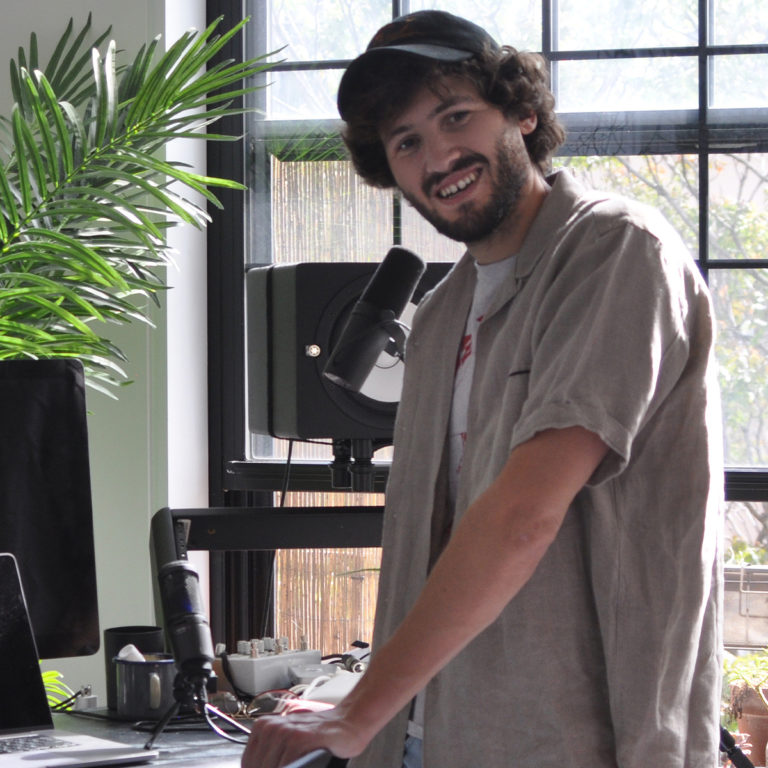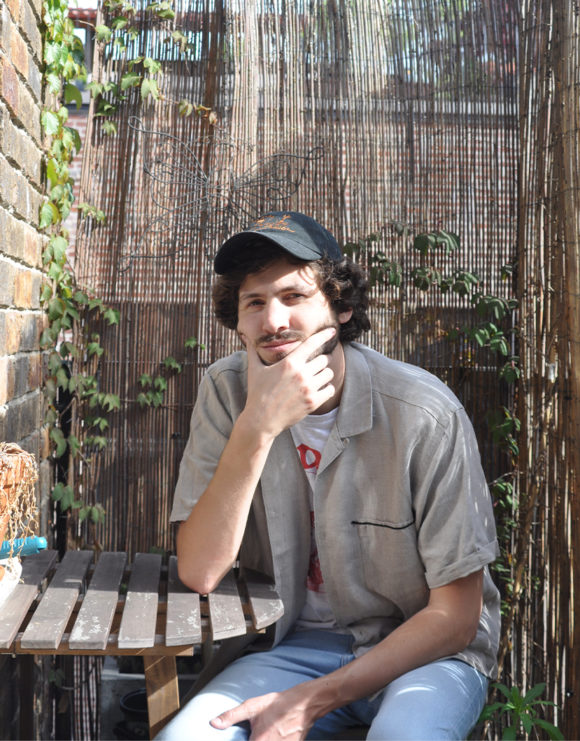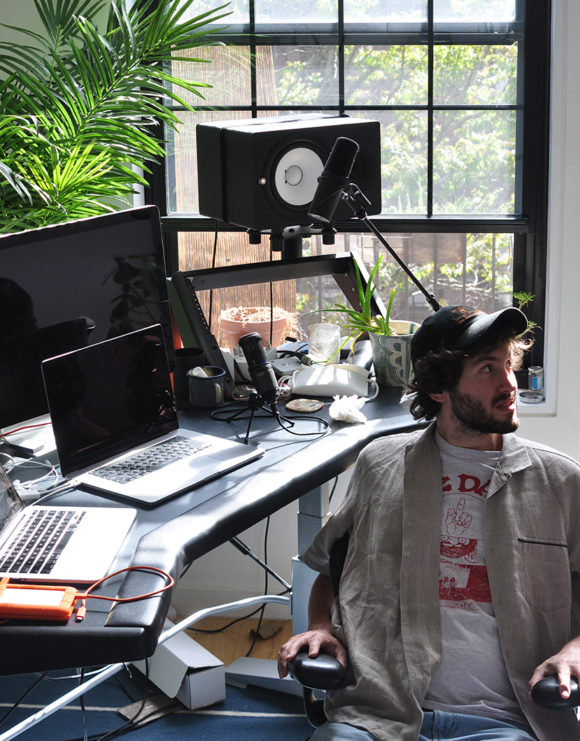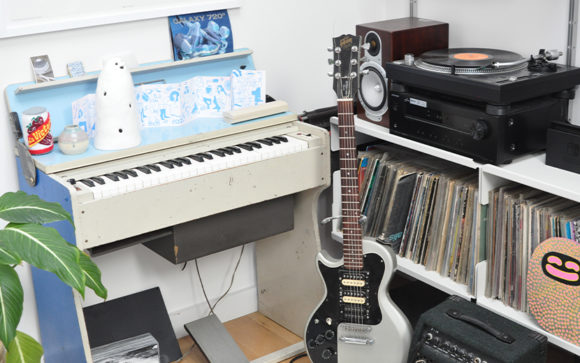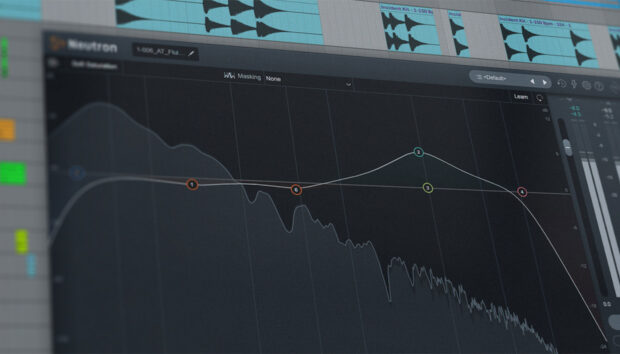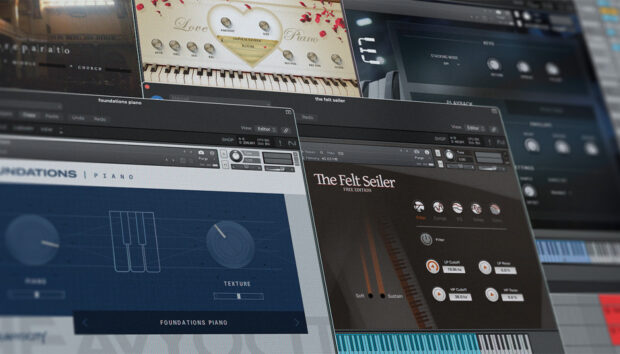Planet’s Mad, the Grammy-nominated new album from Baauer, is squelchy, crunchy, squishy and crispy. It’s got bass that oozes and groans, percussion loops layered into thick and crispy chunks and synth elements that twinkle and glide, while human, animal and alien voices dodge in and out of the mix like they’re being chased. It’s got some of the EDM tropes – punchy bass, big compression – you’d expect from the producer of “Harlem Shake” and “Higher” but its influences are more under the radar than big room: 2008 club bangers, high-res videogame soundtracks, post-trap and bloopy future pop in the vein of Hudson Mohawke or A.G. Cook. Planet’s Mad is a deep dive into the organic textures and kooky samples that have always been Baauer’s signature.
“From the beginning, I had a concept for this record,” says Harry “Baauer” Rodrigues, on the phone from his New York City apartment. “I knew I wanted it to be a world of its own. I was thinking about a lot of stuff I loved when I was first getting into electronic music, like Daft Punk’s Discovery and The Avalanches Since I Left You. Those albums felt like their own worlds to me. It’s those things that I didn’t really understand when I was younger that caught my ear and stood out to me. Like Daft Punk looping a Barry Manilow sample in such a weird way on ‘Superheroes’ or Avalanches’ ‘Frontier Psychiatrist.’ I mean, what is going on in that song? I think it’s all those strange things and little details you discover that make you want to listen to something over and over again.”
Along with classic records from The Chemical Brothers, The Prodigy and Fatboy Slim, Discovery and Since I Left You are mostly instrumental but they don’t feel that way, largely because of the way samples are chopped and placed to create a story. When Baauer sat down to make his sophomore album, he decided to do something similar – mostly doing away with the artist vocal features and collabs that dominated his work from 2016 to 2018 and leaning on samples as the main characters and supporting cast. Planet’s Mad began life with the dancefloor in mind – Baauer wanted a set of entirely original productions to play with – and he went through hundreds of loops and sketches to pick the most compelling, then rounded those out with more chilled moments.
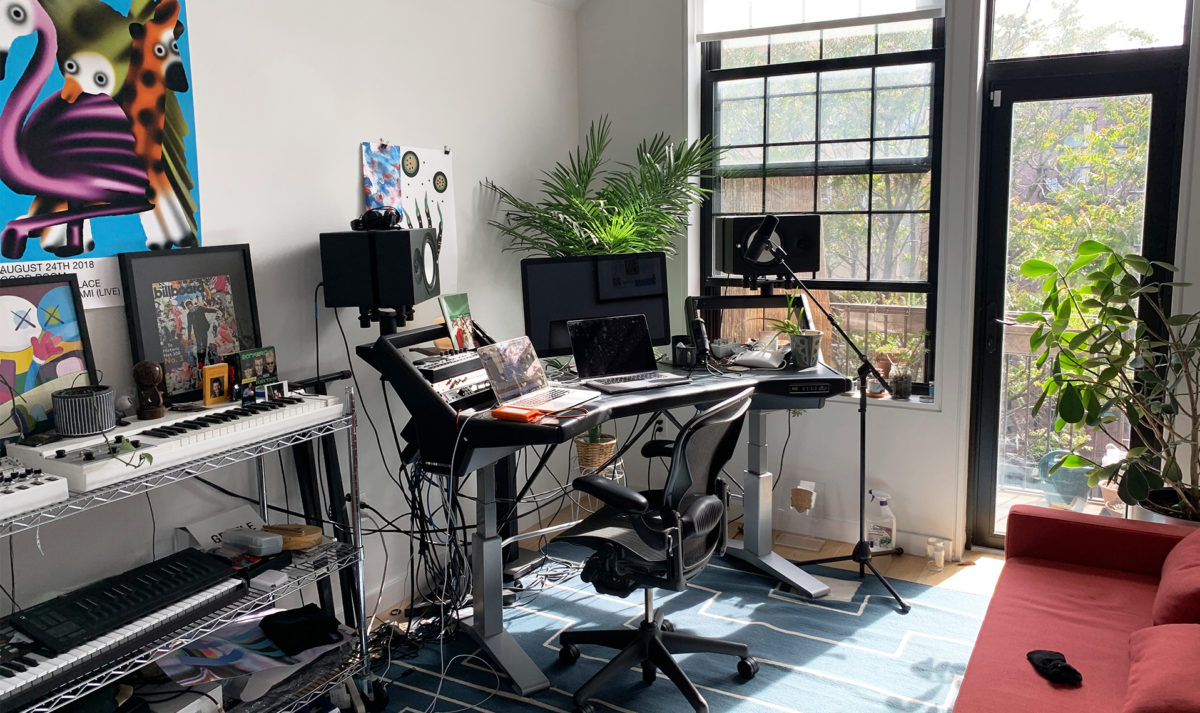
Baauer’s actual production workflow is pretty simple. He spends a lot of time digging for samples all over the internet, in Splice sample packs and in libraries of high-resolution orchestral and percussion loops and shots from Native Instruments’ Komplete and Spitfire Audio; typically, he auditions the samples in Kontakt. He rarely plays things in with MIDI – instead he drops samples into Ableton’s arrangement window, then chops and warps them with a variety of the DAW’s built-in tools. “I’m not really building up four samples into one snare hit, it’s more like I’ll stack four different loops to create one percussive block,” he explains. “I’ll just pull out samples from anywhere and drop them in Ableton. Then I usually try out a lot of things with Ableton’s warp function – flip it up, down, squish it, stretch it – to see how crazy I can make something sound. I usually just use the ‘Beats’ function in Warp Mode, although you can get some crazy effects sometimes with ‘Complex.’) The ‘Segment BPM’ function usually guesses what BPM you want the sample warped to but if you change it to different tempos than the song actually is in you can get some really wild sounds; also, move the warp markers around.”
Baauer mainly uses the built-in stuff in Ableton, mostly because it’s easy and it saves time. “When I got a new computer, I never bothered to re-install a lot of plug-ins because I realized I didn’t really use most of them. I use HalfTime, which gives things a cool half-speed effect and can pull out some cool artifacts, and this thing called LFO Tool, which is like a creative ducking tool that also allows you to automate samples. And then there’s the Ableton OTT preset (inside Multiband Dynamics). It’s this crazy compressor – there’s jokes about it at this point becauseall the big dubstep guys use like 5 instances of it on one sound to make their stuff sound huge. But you can get some really cool effects out of it by using it on different sounds. When you put it on a sample that has some other stuff happening in the background of the recording, it brings everything to the front, which creates some really strange and cool textures.”
Planet’s Mad may sound big but Baauer says he relies more on sample choice and layering for a cinematic feel, rather than using elaborate effects chains. “I actually don’t do much with delays or even panning. I’ve been using a lot of samples designed for scoring films and stuff, like Hans Zimmer-type stuff, so they already sound big as they are and you don’t need to do much to them.” It’s this pairing of really high-resolution sounds with low-grade stuff – like chopped up YouTube rips and interesting Internet detritus – that actually gives Baauer’s music unusual texture.
“You hear it so much when you’re starting out but it really is about choosing the right sample,” he says. “It’s hard to explain, but especially for percussion, I definitely look for things that sound unusual or not perfect. Like if someone is playing a drum loop live and there’s a little cough in it, I would prefer that over something that’s super clean because it has more personality and possibilities to it.” For a similar reason, he prefers sound effects, organic-sounding audio and samples of people playing real instruments being played over digitally-created loops. “I like to dig around and see what unique rhythms and textures I can find, and that more often than not leads me to sounds outside of the traditional Western musical palette. I really love South Asian percussion, especially Tamil drums, and just unusual instrumentation.”
“One of the craziest things I ever sampled was this German guy, I think his name is Budi, who recorded an album of himself slapping his belly. It sounded so sick – I used it on this track “Clang” and when we went to license it he was so thrilled that I had sampled him. Another thing I discovered is this section on YouTube where it just says “Topic.” It’s hard to explain but it’s basically when an A.I. curates a playlist of all different music that it just pulls from everywhere – mostly things that only have a couple views or no views. I can only stay on it for max 30 minutes at a time because you can really get lost in there, but you can find some real gems.”
Baauer’s hunt for strange and alluring samples has only intensified since he has been Twitch streaming, making insane bops with fans and hosting beat battles judged the likes of Flume, RL Grime and YouTube sensation Rebecca Black. In an accompanying Discord chat room, users offer up their own golden sample nuggets. Now that they know Baauer’s proclivity for the percussion of the world, the #share-samples thread is full of clips of Vanuatu water drumming, the raiding songs of Kenya’s Masai tribe and Peter Pringle playing obscure instruments from the Theremin to the Haken Continuum. Baauer describes one of his new sample plugs as an “obsessive internet collector,” bringing to mind a cyberpunk version of the wizened old man in the junk shop who gives the ’80s hero the cursed treasure.

Baauer makes no secret of the fact that he far prefers making cool 30-second or minute-long loops to finishing and arranging whole tracks. “Let’s be clear, I still am not the best at arranging,” Baauer admits. “But someone gave me this advice: you just have to make an A part and then a B part. And from there it will be easier. Or that might just be the whole song!” While Twitch stokes the fire for instant-gratification beats, Baauer says the community aspect of it has also helped him produce and finish way more music. “I like having the chat there to help me make decisions so I can keep moving instead of getting stuck in my head,” he explains. “It’s like having someone in the studio with you, except it’s a lot of people.” Although he’s never been one to open up on social media, Baauer has found the Twitch streams encourage free-flowing creativity, without the constraints of sample clearances, deadlines and perfectionism. He can make quirky, dumb, funny little bangers that sample babies cooing, fart sounds, Bollywood, cha cha and Gucci Mane in a way that recalls the glory days of bloghouse mashups and lazer crunk, the latter a genre his LuckyMe labelmates basically invented. (You can hear 19 of these hot loops on The Boptape mixtape below.)
Finishing an entire album – and a sophomore one at that – is never easy, but after a couple years of working on projects with a ton of collaborators, Baauer opted to narrow his field down to a few trusted friends for this record. Portuguese producer HOLLY – their friendship solidified via Instagram DM – became a key player. “I sent him a couple things and he sent them back so quickly and they sounded crazy. So I just sent him some more stuff and it kept happening. I have no idea what he does, but it almost sounds like he takes stuff from 2D to 3D. Apparently, he also keeps it pretty simple and sample-based but he just makes cool decisions on how to twist stuff. He uses Fruity Loops and I’ve always loved the way tracks made in FL sound so that might be part of it.” (It’s also possible that there’s some additional texture and ear candy created on Planet’s Mad as HOLLY’s FL Studio artifacts rub up against Baauer’s Ableton sonics.)
The distortion of the DAW itself is actually an important component of Baauer’s sound, one that he didn’t realize until recently. “When I would bounce out my stems and give them to [my mix engineer] Ryan Schwabe, I noticed they would sound like something was missing. We realized that I had been clipping things in Ableton and the program was giving things its own sound. Ryan found something that would distort the stems in a similar way and I kept telling him to turn it up a little more and a little more, trying to re-engineer that same distortion after the fact.” Baauer says working with Schwabe has been crucial to taking his music to the next level and making it sound huge. “There’s no replacement for a good mixing engineer who understands what you’re going for. What I learned is that I need Ryan!” he says, laughing.
Visuals have been equally important to establishing the feel of Planet’s Mad, with Actual Objects (a 3D studio run by Rick Farin, Claire Cochran and Nick Fernet) crafting an entire movie to go with the record in Unreal Engine, a 3D creation platform (mostly used for videogames) that also lends itself to building worlds and modifying things on the fly. The full-length movie that accompanies the album – aesthetically a mix of organic elements and high-tech virtual reality – tells the story of a rogue planet that crashes to Earth, filling the world with aggressive party aliens (a narrative made somehow more gripping by the album’s release in the middle of a pandemic); it’s also a not so subtle nod to Daft Punk’s Interstella 555 movie and Porter Robinson’s Virtual Self project (which, along with Porter’s Worlds album, were inspirations).
While many artists prefer in-person collaboration – and grudgingly accept flying files through the internet – it seems like cyberspace is Baauer’s preferred work zone. Now, with collaborators in place, a stripped-back workflow and no touring schedule for the foreseeable future, he’s been more prolific than ever, releasing an expanded version of Planet’s Mad with new tracks and remixes and teaming up with HOLLY for a live(stream) set where they remixed the entire album from scratch in about a week.
“I never wanted this thing to be only about me,” says Baauer. “I’m really enjoying the community and the collaboration. And I like the fact that these tracks don’t have to end after the album release – it’s like these tracks and visuals can keep going and growing and evolving into different things forever.”








